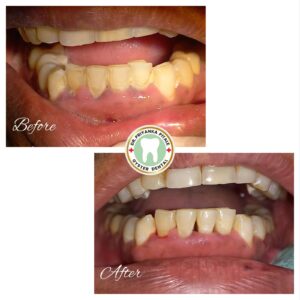
Complete Scaling and Polishing
Complete scaling and polishing are essential dental procedures for maintaining optimal oral health. By thoroughly removing plaque, tartar, and surface stains, these treatments leave teeth clean and smooth. Regular sessions can prevent gum disease and enhance the overall appearance of your smile.
The correct brushing technique and flossing technique are recommended for every individual to maintain good oral hygiene. Complete scaling and polishing are essential dental procedures aimed at maintaining oral health by thoroughly cleaning teeth and removing plaque, tartar, and stains. These procedures are a crucial part of regular dental checkups.
Likewise, routine dental visits and checkups are important so that every time the plaque hardens onto your teeth, it has to be mechanically removed by the machines at the dental clinic.
The hardened or calcified plaque, which is now called calculus, harbors microbes, which, if left as it is, cause infection to underlying gums that reaches underlying bone, forming periodontitis, which may cause mobility and eventually premature loss of your teeth.
At Oyster Dental, we take extra precautions to make sure that our patient is comfortable undergoing even the basics of the treatments.
Complete Scaling and polishing
Scaling
Scaling is the process of removing plaque and tartar (calculus) from the tooth surfaces, especially from areas that are hard to reach with regular brushing and flossing. Plaque is a soft, sticky film of bacteria that forms on the teeth and gums, and if not removed, it can harden into tartar, which is more difficult to remove and can lead to gum disease.
There are two main types of scaling techniques:
1. Manual Scaling: This involves using handheld instruments such as scalers and curettes to manually scrape off plaque and tartar from the tooth surfaces. This method allows us to feel the rough areas on the teeth and remove deposits effectively.
2. Ultrasonic Scaling: This method uses an ultrasonic scaler, a device that vibrates at high frequency and sprays water to break up plaque and tartar. The ultrasonic waves help to dislodge hardened deposits, while the water spray flushes away debris and bacteria. Ultrasonic scaling is often more comfortable for patients and can be quicker than manual scaling.
Polishing
After scaling, polishing is performed to smooth and shine the tooth surfaces. This step helps remove surface stains, making the teeth appear cleaner and brighter. Polishing also helps in reducing the accumulation of plaque on the tooth surfaces.
The polishing process typically involves the use of a slow-speed dental handpiece with a rubber cup or brush attached. A special polishing paste containing fine abrasive particles is applied to the teeth to ensure the teeth surfaces are smooth and are free of stains.
Benefits of Scaling and Polishing
Regular scaling and polishing provide several significant benefits:
Preventing Gum Disease: By removing plaque and tartar, scaling and polishing help prevent gingivitis and periodontitis, which are forms of gum disease that can lead to tooth loss if left untreated.
Fresh Breath: The removal of bacteria and debris from the teeth and gums helps to reduce bad breath (halitosis).
Aesthetics: Polishing helps remove surface stains caused by coffee, tea, smoking, and certain foods, resulting in a brighter, cleaner smile.
Overall Oral Health: Regular professional cleanings contribute to overall oral health, preventing cavities and maintaining the integrity of teeth and gums.
Post-Procedure Care
After scaling and polishing, it is essential to maintain good oral hygiene practices at home. This includes brushing at least twice a day with fluoride toothpaste, flossing daily to remove plaque between teeth, and using an antiseptic mouthwash to reduce bacteria. Regular dental check-ups and cleanings, typically every six months, are also recommended to keep your mouth healthy.
In conclusion, complete scaling and polishing are vital procedures for maintaining optimal oral health. They help prevent gum disease, improve aesthetics, and contribute to fresh breath and overall dental well-being. Regular dental visits and good home care practices are essential to ensuring the benefits of these procedures are long-lasting.